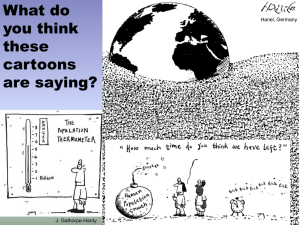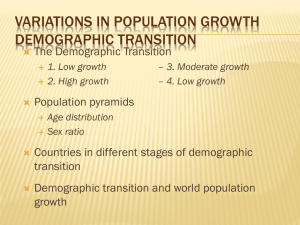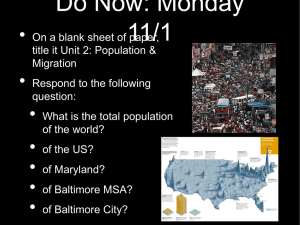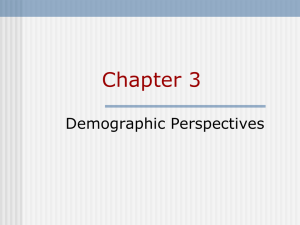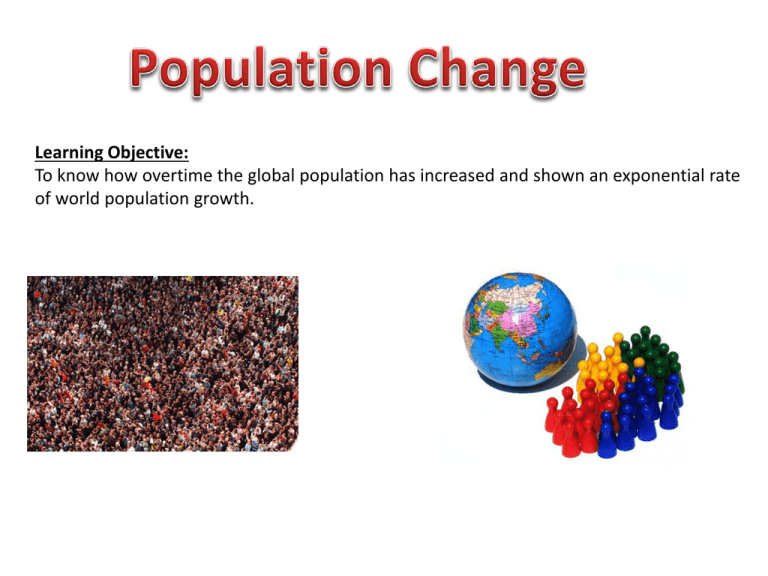
Learning Objective:
To know how overtime the global population has increased and shown an exponential rate
of world population growth.
http://www.poodwaddle.com/clocks/worldclock/
Calls for age-friendly homes
http://news.bbc.co.uk/player/nol/newsid_7260000/newsid_7262100/7262120.stm?bw=
bb&mp=wm&asb=1&news=1&bbcws=1
Ageing population in the UK
http://www.bbc.co.uk/news/world-15368276
Can India feeds its people?
http://www.bbc.co.uk/news/world-15368276
http://news.bbc.co.uk/panorama/hi/front_page/newsid_8625000/8625155.stm
http://news.bbc.co.uk/1/hi/business/8476856.stm
Produce a spider diagram/ concept map to summaries the main
population issues/ topics
World population growth
The growth of world population over the last 200 years has been spectacular and it has not
stopped yet. From 1950 there was a population explosion and the total of 6 billion people
on Earth was reached in 1999. Exponential growth is the term used to describe such a rapid
increase.
Although there is some evidence that the rate of growth is at last beginning to slow down,
the world’s population continues to grow because the majority of countries have higher
birth rates than death rates, leading to natural increase.
Population Key terms
Crude birth rate- the number of live births per 1000 population per year.
Crude death rate- the number of deaths per 1000 per year.
Exponential growth- a pattern where the growth rate constantly increases- often shown as a Jcurve shape.
Life expectancy- the number of years a person is expected to live, usually taken from birth.
Natural increase- birth rate higher than death rate: birth rate minus death rate.
Natural decrease- death rate remains higher than birth rate: death rate minus birth rate
Natural change- the difference between birth and death rate, expressed as a percentage
Annual population change- the birth rate minus the death rate plus or minus migration.
Migration- the movement of people either into or out of an area.
Replacement rate- a birth rate high enough for a generation to be the same size as the one
before it.
Zero growth- a population in balance. Birth rate is equal to death rate, so there is no growth or
decrease.
Birth rates
The average birth rate in the rich, industrialised countries is around 12-13 per
1000; in poor developing countries it is about 26-27 per 1000. There tends to
be a general relationship between birth rate and level of economic
development- the more economically developed the country, the lower its
birth rate.
Birth rates in all European countries are low. In contrast, many countries in
Africa and the Middle East have birth rates well over 40 per 1000.
Death rates
Unlike birth rates, death rates are similar between rich and poor countries; the
world average for both is between 9 and 10. During the second half of the
twentieth century, death rates fell everywhere, due to the spread of medical
knowledge and improvements in primary and secondary healthcare.
Primary healthcare- preventing disease e.g. by immunisation
Secondary healthcare- treatment of illnesses by doctors and nurses.
Countries with death rates above 20 per 1000 are now quite exceptional.
Countries in southern Africa are badly affected by the spread of HIV/Aids, unable
to afford the anti-viral drugs. Sierra Leone was wartorn for many years and
Zimbabwe is in economic meltdown with severe food shortages. Here trend
towards lower death rates has been reversed.
It is estimated that by 2050 the global population will be
about 9 billion. The map shows their projected distribution. It
looks strange because the countries have been drawn in
proportion to their estimate populations.
Look at the size of Africa and Asia- it is thought that, by 2050,
62% of all people will live in Africa, and South and East Asia.
Learning Objective:
1) To know how countries pass through different stages of population growth as
shown in the five stages of the Demographic Transition Model (birth rate, death
rate and natural population changes) and how it changes population structure
2) To understand the impact of increasing urbanisation, agricultural change,
education and the emancipation of women on the rate of population growth.
Rainforest tribes, Ecuador- stage 1
Afghan nomads- stage 2
A lot of countries have similar patterns of population change over time so they devised
the Demographic Transition Model.
• Demographic- is to do with population or people
• Transition- means change
• A model is a simplified version of something that happens in real life
The model has worked quite well for countries that have gone from a rural, poorly
educated society to an urban, industrial, well-educated one. So it fits what happened in
the UK, the rest of Europe, and other richer countries like Japan and the USA. But
poorer countries might not follow the same pattern.
The demographic transition model (DTM)
High
High
fluctuating
Natural
decrease in
population
( BR< DR)
Early expanding
Natural
increase in
population
Late
expanding
Low
fluctuating
Decline
Birth rate
Total population
(BR> DR)
Death rate
Low
Modernisation/ economic
development
2) Where would these statements fit on the DTM?
• The church no longer needs a team of full-time grave diggers
• The family has just buried their fifth of 12 children
• Families are very big and children have to share rooms
• The town is proud of its new sewerage system
• The retirement age is going up and people have to work longer
• Very few children know their grandparents
1) How has the UK’s
population changed
over time?
The demographic transition model (DTM)
High
High
fluctuating
Early expanding
Late
expanding
Low
fluctuating
Decline
Birth rate
Natural
decrease in
population
( BR< DR)
Natural
increase in
population
Total population
(BR> DR)
Death rate
Low
Modernisation/ economic
development
The demographic transition model (DTM) describes
how the population of a country changes over time.
It gives changes in birth and death rates, and shows
that countries pass through five stages of population
change.
The demographic transition model (DTM)
High
High
fluctuating
Early expanding
Late
expanding
Low
fluctuating
Decline
Birth rate
Natural
decrease in
population
( BR< DR)
Natural
increase in
population
Total population
(BR> DR)
Death rate
Low
Stage 1 (high fluctuating)- high birth and death rates that fluctuate. The
population remains stable but low.
Birth rate is high because:
No countries in Stage 1, but
some tribes in Brazil’s
rainforests. UK was stage 1
before 1760.
-
There is a lack of birth control
-
Women also marry young
-
Children and need to work in fields to support the family’s income
Death rate is high because:
- disease, war, famine, lack of clean water and medical care
The demographic transition model (DTM)
High
High
fluctuating
Early expanding
Late
expanding
Low
fluctuating
Decline
Birth rate
Natural
decrease in
population
( BR< DR)
Natural
increase in
population
Total population
(BR> DR)
Death rate
Low
Stage 2 (early expanding)- high birth rate but falling death rate.
The population increases rapidly.
Birth rate is high because: (same reasons as in stage 1)
Death rate falls due to:
Countries like Nepal and
Afghanistan are in Stage 2
-
Improved medicine
-
Cleaner water and improved sanitation
-
More and better food
The demographic transition model (DTM)
High
High
fluctuating
Early expanding
Late
expanding
Low
fluctuating
Decline
Birth rate
Natural
decrease in
population
( BR< DR)
Natural
increase in
population
Total population
(BR> DR)
Death rate
Low
Stage 3 (late expanding)- birth rate declines rapidly while death rate falls
slowly. Population growth slows down. Reasons for falling birth rate include:
Egypt is in Stage 3 along with
India, Kenya and Brazil- most
countries at lesser stages of
development.
-
Fewer people are farmers who need children to work
-
Birth control is now available
-
Number of infant deaths are falling
-
Women are staying in education longer and marrying later
Death rate still falling- for the same reasons as in stage 2
The demographic transition model (DTM)
High
High
fluctuating
Early expanding
Late
expanding
Low
fluctuating
Decline
Birth rate
Natural
decrease in
population
( BR< DR)
Natural
increase in
population
Total population
(BR> DR)
Death rate
Low
Stage 4 (low fluctuating)- low birth rate and low death rate, both
fluctuate. Population growth is small but the population remains high and
stable while fertility continues to fall.
Most developed countries e.g.
most of Europe and USA are in
Stage 4
There are significant changes in personal lifestyles. There is increased
access and demand for luxuries like holidays and material possessions so
less money is available for having children. There are more women in the
workforce, with many people having high personal incomes and more
leisure interests. Also they are not needed to work for the family. People
are now having the number of children they want.
The demographic transition model (DTM)
High
High
fluctuating
Early expanding
Late
expanding
Low
fluctuating
Decline
Birth rate
Natural
decrease in
population
( BR< DR)
Natural
increase in
population
Total population
(BR> DR)
Death rate
Low
Stage 5 (natural decrease)- a later period, during which the birth rate is
very low and goes below the death rate
Reasons for the low birth rate:
• a rise in individualism, linked to emancipation of women in the labour
market
Only recognised in recent years in
some western European countries
and highly developed rich ones e.g.
Japan, Italy, Germany.
• greater financial independence of women
• concern about the impact of increased population numbers on
resources for future generations
• a rise in the concept of childlessness, as they are expensive to raise and
many people have elderly dependents so have no kids
The demographic transition model (DTM)
High
High
fluctuating
Early expanding
Late
expanding
Low
fluctuating
Decline
Birth rate
Natural
decrease in
population
( BR< DR)
Natural
increase in
population
Total population
(BR> DR)
Death rate
Low
Stage 5 (decline)
Reasons for the low birth rate:
• an increase in non-traditional lifestyles, such as same sex relationships
• the death rate remains steady or slightly increases as there are more
elderly people (ageing population) so more people may die of old age
despite advances in health care.
Major factors affecting world population growth
Changes to farming method
If people rely on farming, and there is little technology, they often have large families to
provide extra workers. As technology increases, and countries develop, fewer people are
employed in farming and the need for large families declines.
Urbanisation
As farming methods change, and fewer people are needed to work on the land, many rural
people move to urban areas to work. They need fewer children there, so they have smaller
families.
Education and women
As society and economy develop, women tend to stay in education longer. This means they
get married and start having children later, and usually have fewer children as a result.
Educated women also know more about birth control, and so can limit their families more
effectively.
How do we use population pyramids?
Learning Objectives:
1) To know how to construct a population pyramid
2) To understand how to interpret population characteristics from a pyramid and
how to predict likely future changes in a population.
Age structure: the proportions of each age group in a population. This links closely to the
stage a country has reached in the demographic transition model.
Gender structure: the balance between males and females in a population. Small
differences can tell us a great deal about a country or city.
Infant mortality: the number of babies that die under a year of age, per 1,000 live births.
Child mortality: the number of children that die under five years of age, per 1,000 live
births.
A population pyramid is a type of bar graph used to show the age and gender structure of a
country, city or other area based on census data. The horizontal axis is divided into either
numbers or percentages of the population. The central vertical axis shows age categories:
every 10 years, every 5 years or every single year. The lower part of the pyramid is known as
the base and shows the younger section of the population. The upper part, or apex, shows
the elderly.
Interpreting population pyramids tells us a great deal about a population, such as birth
rates, to a lesser extent death rates, life expectancy and the level of economic development
(or stage in the DTM).
Pyramid for Ethiopia- Stage 2
Pyramid for UK- Stage 4
The pyramid for the UK is taller
and the top is more pronounced,
showing significant numbers
above the age of 65. The UK’s
birth rate is low and the narrow
base shows this. It is the middleaged groups that are dominant in
pyramids for developed
countries.
Population pyramids for developing countries are wider at the base, narrower at the
top and less tall than those for developed countries.
The pyramid for Ethiopia displays many of the
Characteristic features of a less economically
developed country, particularly the wide base
showing a population structure dominated by
young people, due to high birth rates. The
graph has an almost perfect pyramid shape,
progressively tapering towards a narrow top,
with few people above the age of 65.
It is customary to subdivide the structure of a country’s population into three age groups,
namely young (0-14), middle-aged (15-64) and old (65 and above). The middle-aged are
distinguished from the other two as the working or independent population; they are
the group in society that works, earns money, contributes to pensions and pays income
taxes. Young and old have in common that they are dependants; although some of them
work, the majority depend upon services such as education and healthcare, paid for by
taxes collected from the working population. The dependency ratio is the ratio between
the dependent and independent populations.
Look at the two population pyramids
for Mexico.
1) Describe each pyramid’s shape
2) Explain the changes between 1980
and 2000.
Mexico’s population pyramid for 1980:
• Shows a large, youthful population aged 0-15
• Shows a modest-sized, middle aged population aged 16-64
• Shows a small, elderly population aged 65 and over- for both males and females
• Has a slightly concave pyramid shape
Mexico’s population pyramid for 2000:
• Shows a large youthful population, with more people surviving into the 5-15 year age
range
• Shows a ‘thickening’ of the pyramid in the middle age ranges
• Shows some increase in the number of elderly people- particularly females
• Has an almost perfect pyramid shape
The main reason for the differences between these two pyramids is Mexico’s reduced death
rate. More babies are surviving and its people are living longer- due to improved levels of
health care and the increasing vaccination of infants.

